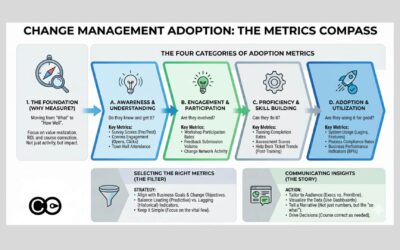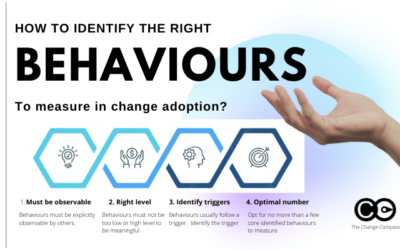Managing multiple change initiatives is not a new concept nor is it new to organizations. What is perhaps ‘newer’ is how change practitioners are using data to manage multiple changes. Change practitioners that manage a portfolio of initiatives used to focus on...
Latest Blogs •
Mastering Enterprise Change Management Through Reporting
Enterprise change management reporting is changing. In today’s dynamic business environment, it no longer consists of general updates on organisational change management efforts, change leaders, streams of project progress, or updates on various change capability...
Change Readiness Assessment: A Strategic Approach
Change readiness is one of the most critical, yet often misunderstood, concepts in organizational change management. For many practitioners, it’s been reduced to a series of surveys or assessments — a simple gauge of how “ready” stakeholders feel. But this...
How to measure change saturation
Digitisation, competition and changing industry conditions have amongst other things brought on an accelerated change agenda for a lot of organisations. What were previously thought to be 1 to 5 year horizons of change suddenly became an immediate...
The Ultimate Guide to Change Metrics Your Executives Want To See
Why Nailing the Right Change Management Metrics is Critical and Can Make or Break Your Reputation As organizations strive to adapt and thrive in dynamic environments, how the change management process is tracked has become a strategic imperative. However, the success...
Unlock Change: How to Measure and Grow Effectively
Scaled Agile Framework (SAFe) has emerged as a leading methodology to address the organisational change demands of fostering flexibility, collaboration, and continuous improvement. A cornerstone of SAFe is the principle of 'Measure and Grow,' which emphasizes using...
Key Change Management Metrics Examples You Should Avoid
Successful change management relies on having the right metrics to measure progress, gauge impact, and communicate with stakeholders. Moreover, the right metrics can drive continuous improvement and help directly achieve change outcomes. However, not all metrics are...
The Comprehensive Guide to Change Management Adoption Metrics
Change management is an intricate dance between vision, strategy, execution, and perhaps most importantly, adoption. The ultimate goal of any change initiative is not merely to implement new systems, processes, or regulations but rather to embed these changes into the...
How to measure change adoption
How can understanding the change adoption curve benefit organizations? Understanding the change adoption curve benefits organizations by identifying how different individuals or groups respond to change. By recognizing these stages—innovators, early adopters, early...
Understanding Change Management Heat Map: A Visual Guide
Why heatmaps are not the best way to make change decisionsby | Change MeasurementChange heatmaps are one of the most commonly used charts when making business decisions on whether there is too much change or not. Yes there are some advantages of using...
Measuring behaviours in change adoption – Infographic
Measuring behaviours as a part of change adoption is a key part of effective change management, ensuring the full achievement of initiative benefits and helping practitioners understand whether impacted stakeholders are truly moving toward the future state. Behaviour...
From change management data to business impact – Infographic
There are many steps in getting from collecting change management data to making business impact. Data does not equal business impact.Is the data you’re showing presented in the right graphics, timelines or templates and contain the right key information for the right...











